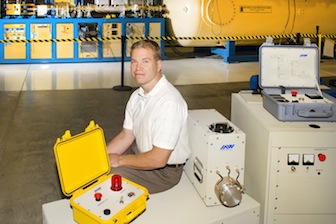Idaho State University Idaho Accelerator Center’s linear accelerators used to check Mars rover’s power supply
August 6, 2012
The $2.5 billion Curiosity rover successfully landed on Mars on Aug. 6 and Idaho State University's Mike Smith is confident about his part on powering the automobile-size craft that has travelled more than 339,000,000 miles to the Red Planet.
"It's exciting and I am glad the Idaho Accelerator Center is doing work that is in this realm," said Smith, an engineering physicist with the ISU Idaho Accelerator Center.
 Smith designed the portable linear accelerators that the Idaho National Laboratory used to check the welds on the Curiosity's nuclear power supply.
Smith designed the portable linear accelerators that the Idaho National Laboratory used to check the welds on the Curiosity's nuclear power supply.
"We're rock-solid on the integrity of our testing," Smith said. "There is so much research and writing on the technology we use that if there was the slightest question about the integrity of our testing everything would halt. They’re not ready to take a chance on something like this. It is rock solid."
Portable linear accelerators developed at the IAC were also used to check the welds on the spacecraft New Horizons, which was launched in January 2006 and is expected to reach Pluto in July 2015.
On such costly, important and demanding missions it is important that the welds hold on the metal cases used to encase the plutonium-238 that is used to power the rover. Curiosity uses as its power source a Multi-Mission Radioisotope Thermoelectric Generator, which is a nuclear battery that uses the heat supplied by plutonium 238 to create electricity.
"I follow the missions pretty closely because there is a lot riding on it," Smith said. "It is exciting to watch and I like to see how it is going because the Idaho Accelerator Center has something invested in it."
The plutonium is encased in iridium, the most corrosion-resistant metal, to form what is called a fueled clad. The welds on this fueled clad must be strong enough to not allow radioactivity material to leak and to ensure the MMRG has fuel.
The IAC's portable accelerators speed up electrons that travel near the speed of light. Those electrons are converted to high-energy photons or X-rays and are fired into the fueled clad, giving X-Ray images. Those X-ray images are used to confirm the integrity of the fueled clads.
The Curiosity is the sixth NASA spacecraft to land on Mars. It travelled through space for more than eight months to reach its destination. The one-ton Curiosity rover is designed to investigate whether Mars is, or ever was, capable of hosting microbial life.
###
Categories:
